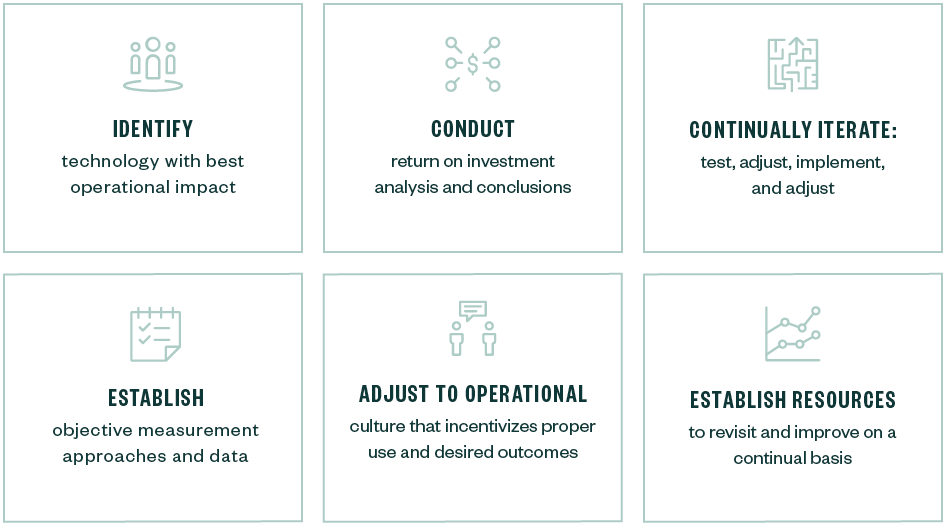Value Your Employees
In the restaurant and hospitality industries, the success of your enterprise always begins with people.
Considering daily operations is key, especially related to people. Many operational strategies were reconstituted quickly and continue to adapt to focus on the big people-related aspects of the business.
When the pandemic first accelerated, restaurants, hotels, and tourist attractions shut down and furloughed many employees. Many owners and operators worked to support employees by leveraging programs such as the Paycheck Protection Program (PPP), Economic Injury Disaster Loan (EIDL), Restaurant Revitalization Fund (RRF), and employee retention credits (ERC, sometimes referred to as the ERC credit), while trying to maintain operations and financial viability for their businesses.
Employees received unemployment benefits enhanced by federal, state, and local governments to support their families during fluctuating shutdowns. These programs ran their legislated course and largely concluded in 2021.
Many former employees used this period to further their educations, leverage skill sets, and test their worth in the marketplace for similar or different vocations. As a result, many employee groups moved en masse as part of The Great Resignation, creating staffing challenges not seen by employers in decades.
In the hotel industry, the ability to hire cleaning staff, night management, and others, have directly influenced how many hotel rooms could be reserved and occupied.
Restaurants, in many cases, have reduced operating hours and shifts, as they’ve struggled to hire and train enough staff to support operations.
Primary Employee Value Tactics
The drive to locate and attract capable people began in 2021 and continues to be a major focus for many businesses well into 2022.
Wage rates have escalated and continue to evolve in competition for people in the marketplace. Many offer health care, educational benefits, or more flexible schedules hoping to attract employees who are in school or have childcare needs.
Tactics to Attract and Value Staff
- Offer competitive pay and benefits
- Maintain flexible hours
- Provide instant pay or pay card options
- Enhance funding and implementation of training
- Follow up and reinforce prior training
- Encourage employee feedback
- Create an enjoyable and safe working environment
- Enhance one-on-one supportive coaching and advancement policies
- Closely monitor management personnel, policies, and practices
Keeping employees in the loop is of critical importance. To do so:
- Share your vision—what, how, why, and when
- Tie operational actions to the business’s tactics, budgets, and compensation
- Update operational actions and vision biannually
- Celebrate successes
Ongoing Challenges from the Labor Shortage
Labor shortages are one of the premier challenges that hospitality and restaurant consultants anticipate, at minimum, for the balance of 2022 and 2023. Continued challenges to management focus, service offerings, and labor costs can be expected, even when employing the labor actions mentioned above.
Rethink Your Supply Chain
Like many other sectors, restaurants and hospitality aren’t spared from myriad issues affecting the overall supply chain. At present, these issues bring significantly inflated costs for food, paper, and supplies, along with reduced profitability.
Restaurant menus are being pared down to reflect key items that are available and to help improve gross margins. Menu prices have also increased considerably in some places to offset the rising cost of goods sold and labor.
Sourcing Strategies to Consider
- Reduce number of deliveries per week
- Reengineer product recipes and ingredients
- Increase product order quantities to lower per-unit costs
- Negotiate with suppliers on product quantities and price hedging
- Leverage supply chain consultants with measurable cost incentives
- Utilize cooperative purchasing practices with other buyers
Utilize Technology to Improve Efficiency
Implementing new processes and systems can take time for efforts to pay off. In the meantime, you have daily business to conduct.
Technology investments, such as automated ordering solutions and ideal food cost systems for example, are gaining appeal as countermeasures to labor and supply shortages, as well as to offset price increases to customers. Some of these have been around conceptually for decades and have been enhanced through lessons learned and improved technology platforms.
Discover and implement new technology solutions with the following process.
How to Discover and Implement New Technology

It’s important to have practical expectations on time frames and costs for rolling out technology on a large scale.
Technology to Help Overcome Labor Shortages
Long-term technology investments could help overcome labor shortages while also being challenging to deploy, debug, and incorporate into day-to-day practices.
Examples of technology to help overcome labor shortages:
- Automated consumer-driven order-entry kiosks
- Labor management systems, especially for larger multi-unit concepts
A labor management system should be able to conduct and provide opportunities to:
- Create engineered activity-based labor standards
- Rethink staffing schedules throughout each week
- Reduce overstaffing and proactively identify staffing voids by position
- Improve customer service
- Model and deploy for continual improvement
- Provide best-in-practice feedback to leverage outcomes
Reduce Energy Consumption
Energy Consumption
Reducing a restaurant or hotel’s total energy consumption can create room in the budget to increase wages, invest in new technologies, and provide a way to minimize rising menu prices, all while meeting organizational green initiatives.
Following are a few ways you can target your energy usage:
- Invest in energy management systems, including hardware, software, and system selection guidance
- Gain support and advice from local energy companies and energy management solutions firms
- Follow up on best practices location by location
Additional Considerations for Restaurants
There are additional industry-specific considerations to explore beyond these four initial areas of operational focus.
Ongoing and future considerations for restaurants include:
- Brand positioning
- Labor-related initiatives
- Improvement investments
- Concept repositioning
Brand Positioning
Brand repositioning is a key consideration for restaurants restructuring their strategy. These can reflect shifting customer needs, targeted markets, location choice, and supplier limitations.
Your brand positioning can and should reflect the new customer considerations. This could include trends in customer ordering approaches, vaccination status in your target markets, continued hesitations surrounding the pandemic, income variability, and much more.
Labor-Related Initiatives
Explore the following people-first initiatives for your operational actions:
- Enhanced and customized training
- Incentive systems
- Message management for prospective employees
Improvement Investments
If you have room for ongoing improvements in your operational actions, either financially or through personnel initiatives, consider the following upgrades:
- Operational systems, processes, and culture
- Labor-management systems
- Ideal cost of sales
- Utility management
Concept Repositioning
Throughout the beginning of 2022, the restaurant industry tried to meet the growing consumer popularity of third-party delivery platforms among customers seeking convenience for a price, all happening amid other lifestyle changes that stemmed from the pandemic, such as working from home.
This evolution has prompted many businesses to reevaluate how they reposition their business operations.
Key focus areas to consider when repositioning the concept of your business include:
- Delivery versus eat-in
- Full versus limited service
- Web versus in-person ordering
- Menu offerings
- Brand identity and marketing
Notes on Delivery
With the ability for dine-in experiences curtailed at various stages of the pandemic, many restaurant operators—and grocers, for that matter—jumped on the opportunity to dial in the efficiency of their off-premise practices, such as carryout, drive-through, and delivery.
Delivery, while once only applicable to certain restaurant sectors, such as pizza and Asian cuisine, has achieved traction in ways not thought possible before. According to some projections, the US ecosystem for restaurant delivery solutions has roughly doubled in size in the last 18 to 24 months—a level of growth that was not previously expected for at least another five years.
Additional Considerations for Hotels and Lodging
The reduced ability to operate at full capacity because of constricted cleaning staff and increased expectations for level of cleanliness has produced problems across the board for a hotel’s full-service offerings. In turn, this significantly reduces the financial viability of certain properties and the property’s ability to meet guest expectations or even maintain a standard customer experience.
As with restaurants, ongoing and future operational considerations for hotels and lodging include the following:
- Brand positioning
- Labor-related initiatives
- Improvement investments
- Concept repositioning
Brand Positioning
To counter the potential spread of COVID-19, federal guidelines and state and local ordinances were enacted to modify day-to-day operations of many businesses. This affected long-term operations and much more.
Some hotels and lodging businesses are investigating brand repositioning options to adapt to new customer expectations, whether they’re traveling for business or leisure.
Brand positioning considerations for the hotel and lodging industry include:
- Change the brand image to better suit new customer expectations
- Adjust marketing and advertising to communicate
- Restructure current service offerings and train employees with new ways to talk with customers
- Reevaluate site selection criteria to reach out to new targeted customers in the longer term
Labor-Related Initiatives
The hospitality industry faces unique labor shortage challenges, which can affect the operational capacity of the entire business.
Labor-related strategies to incorporate in your operational actions include:
- Find creative, nontraditional employee sources
- Explore self-check-in technology for the front desk
- Create enhanced wage and benefit plans
- Offer limited daily housekeeping services upon customer check-in
- Weigh the viability of maintaining or limiting restaurant facilities
Improvement Investments
If you have cash and personnel for improvements in your operational actions, you might:
- Invest in labor-related technologies
- Make operational improvements during reduced operations
- Improve the overall quality and image of facilities
Concept Repositioning
During the first two years of the pandemic, the restaurant and hospitality industries, which traditionally relied on in-person interactions, adapted and revamped employee health management policies. With a renewed focus on properly disinfecting work surfaces, equipment, rooms and customer dining areas, as well as social distancing protocols, many businesses were forced to modify service practices and work spaces.
Many of these protocols seem set to continue for the foreseeable future. To adapt to new customer expectations, consider the following options:
- Reposition location of properties to adjust to changing trade areas
- Rethink food service as an expected service offering
- Adjust breakfast to pre-packaged carry-away offerings
We’re Here to Help
Whatever challenges come to pass, if a restaurant or hotel is outfitted with an operational action plan and a good advisor on-hand, they’ll be more likely to weather the storm and prosper.
For questions about how to navigate the evolving business landscape, contact your Moss Adams professional. You can also learn more about increasing cash flow, how to sell your restaurant or hospitality business, or explore more insights through our Restaurant and Hospitality practices.

